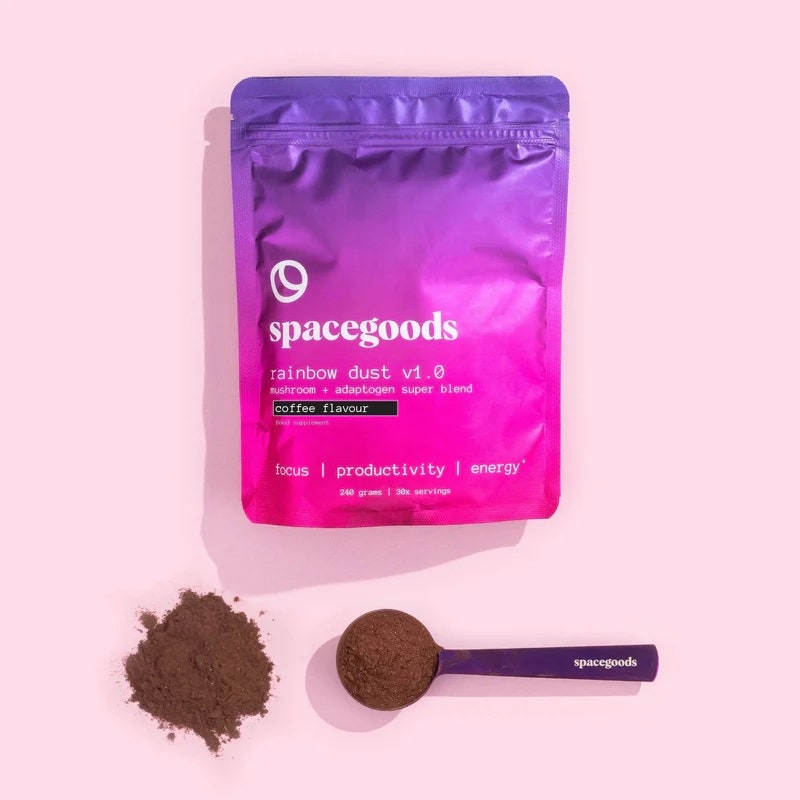While Four Sigmatic injects its adaptogens directly into coffee grounds, many adaptogenic drinks are promoted as an alternative, often with a lower caffeine content. UK-based Spacegoods, Rainbow DustHoused in a bright pink and purple container, the can’t-miss powder packs 80 milligrams — less than most coffees. Its ingredient list includes lion’s mane, cordyceps, and chaga mushrooms, along with other plant-based adaptogens like ashwagandha, maca root, and rhodiola rosea. That’s a lot to cram into a scoop of the powder, which comes in chocolate, coffee, strawberry, vanilla, and cinnamon flavor options and a decaf raw cacao variety.
Courtesy of Spacegoods
E-commerce entrepreneur Matthew Kelly launched the brand in 2022 following the failure of his previous business, an online neon sign retailer that filed for bankruptcy in 2021. Kelly stumbled upon functional mushrooms while struggling to figure out his next move.
Kelly’s e-commerce background is clearly reflected in Spacegoods’ online presence. Like many of the functional beverage brands that sell direct to consumers, the company heavily promotes a subscription model, and after purchasing Rainbow Dust, I found myself bombarded by Instagram ads and marketing emails promising all sorts of benefits.
Kelly admits that advertising adaptogenic drinks requires walking a fine line. Manufacturers want to tout the potential benefits of their products, but the UK’s Advertising Standards Authority bans claims that food products could prevent, treat or cure human diseases; several brands have had to pull ads who mention health conditions such as anxiety, dementia or ADHD.
I tried Rainbow Dust’s original chocolate flavor and found it cloyingly sweet. True, it didn’t taste like mushrooms, but it didn’t exactly remind me of a health drink. Kelly admits that promoting a chocolate-flavored drink as an upgrade to coffee may have confused some buyers; he prefers the coffee flavor, which was introduced this year.
Those with a more mature palate may want to try the American brand. MudWTR—a name that founder Shane Heath says was inspired by his colleagues’ reactions to his homemade prototypes and ended up going “naturally viral.” Heath, a former caffeine addict, turned to coffee alternatives after noticing negative effects on his sleep and mood. His motto: “I wasn’t mad at coffee, just disappointed.”
Whisky Review
The original version of MUDWTR contains just 35 milligrams of caffeine, along with lion’s mane, cordyceps, chaga, and reishi mushrooms, as well as a few other ingredients. Its real winning formula, however, is in its cocoa-masala chai flavor. The natural earthiness of the spices skillfully masks any unpleasant mushroom flavor. Prepared by mixing it with hot water or milk, it doesn’t feel anything like coffee, but still has a sophisticated feel (although I did find quite a bit of sediment at the bottom of the cup).
At first I scoffed at the company’s insistence on selling its powder in a starter kit containing a mini electric frother, but as I brewed a cup, I recalled Spector’s observation about the role of ritual in amplifying perceived benefits and wondered if this extra brewing step was in fact a shrewd decision. It forced me to pause, which, in itself, inspired my focus.Okay, I’m going to make this drink and then sit down and write that story. I’m pretty sure my productive writing session afterwards was largely a result of the placebo effect, but I’ll accept it.


